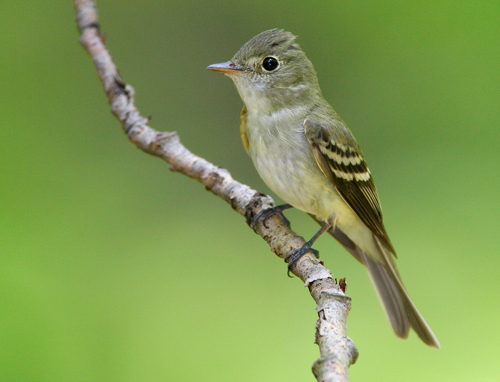Acadian Flycatcher

Photo credit: Brian E. Small
Species information
The following is a report on progress made towards the protection and recovery of Acadian Flycatcher (Empidonax virescens) in Ontario from 2007 to 2021, based on Ontario’s species-specific recovery policy. This report meets the legislative requirement for a review of progress under the Endangered Species Act, 2007 ( ESA or “the Act”). Acadian Flycatcher is listed as endangered on the Species at Risk in Ontario (SARO) List under the ESA.
Acadian Flycatcher has been classified as a species at risk since 2004. It was originally classified as an endangered species and was listed as such under the ESA when it came into force in June 2008.
Acadian Flycatcher has been protected from being killed, harmed, harassed, captured or taken since 2008.
In addition, the habitat of Acadian Flycatcher has been protected from being damaged or destroyed since 2013.
The species-specific recovery policy for Acadian Flycatcher, known as the Government Response Statement (GRS) was published in 2017 and includes the government’s recovery goal for the species and the actions and priorities it intends to lead or support to help achieve that goal. The GRS considers science advice provided in the recovery strategy, when developing recovery actions for the species. As legislated in the Act, the purpose of this Review is to report on progress made towards implementing the protection and recovery actions in the GRS. The review can also help identify opportunities to adjust and adapt the implementation of protection and recovery actions to achieve the recovery goal for the species.
Further information about Acadian Flycatcher, including the threats that it faces, and actions being taken to help protect and recover this species is available on the Government of Ontario webpage for Acadian Flycatcher. A summary on the progress towards the protection and recovery of Acadian Flycatcher and an annual update on the broader species at risk program (i.e. the Introduction to the 2021 Review of Progress report) is available on the Review of Progress Towards the Protection and Recovery of Ontario’s Species at Risk webpage.
Snapshot: Progress towards the protection and recovery of Acadian Flycatcher
Progress towards meeting the recovery goal
- The recovery goal in the Government Response Statement (GRS) for Acadian Flycatcher in Ontario is to “maintain the current population abundance and distribution of the species in Ontario and enable natural increases, where feasible, through habitat management”.
- Progress has been made towards implementing all of the government-led actions. Progress has been made towards implementing all of the government-supported recovery objectives and a majority of the associated actions. Examples of progress include:
- the development of site-specific management plans to help maintain and improve Acadian Flycatcher habitat
- surveying efforts undertaken for Acadian Flycatcher at varying scales across woodland habitats
- In alignment with the GRS, greater efforts are needed to support the securement of Acadian Flycatcher habitat, to develop best management practices around drainage in or adjacent to Acadian Flycatcher habitat, and to conduct research on the potential impacts to Acadian Flycatcher associated with food abundance and diversity.
Occurrences and distribution
- Acadian Flycatcher is widely distributed across southern Ontario, with an estimated range of approximately 13,800 square kilometres based on recent observations.
- The Natural Heritage Information Centre (NHIC) has received over 1,670 records of the species based on observations made between 1909 and 2021.
- Since 2008, the species has been observed in locations where they were not previously known to occur and at locations previously thought to be historical.
Government-supported stewardship projects
- Through the Species at Risk Stewardship Program, the Government of Ontario has enabled its stewardship partners to conduct 49 projects (by providing $2,873,610 in funding) that have supported the protection and recovery of Acadian Flycatcher.
- The government’s support helped its stewardship partners to involve 6,933 individuals who volunteered 38,909 hours of their time towards protection and recovery activities for species at risk, including Acadian Flycatcher. The estimated value of these voluntary contributions, as well as additional funding and in-kind support, is $4,002,902.
- Stewardship partners reported that through their actions 7,537 hectares of habitat were enhanced for Flycatcher and other species at risk that inhabit the same ecosystem.
- Stewardship partners reported providing outreach on multiple species at risk, including Acadian Flycatcher, to 769,027 individuals.
Supporting human activities while ensuring appropriate support for species recovery
- The Government of Ontario has issued fourteen ‘protection or recovery’ permits for this species under clause 17(2)(b) of the ESA.
- Fifty-five activities have been registered for the species. The activities were registered under ‘Drainage works‘ (section 23.9), ‘Threats to human health and safety, not imminent’ (section 23.18), and ‘Wind facilities’ (section 23.20) under Ontario Regulation 242/08 of the ESA.
Reporting on the progress towards the protection and recovery of Acadian Flycatcher
Recovery goal
The government’s goal for the recovery of Acadian Flycatcher is tomaintain the current population abundance and distribution of the species in Ontario and enable natural increases, where feasible, through habitat management.
The implementation of government-led and government-supported actions demonstrates progress towards reaching the desired objectives and the recovery goal set out in the GRS.
Progress towards implementing government-led actions
Progress has been made towards implementing all government-led actions identified in the GRS. Common actions for the government to lead as it works towards achieving a species’ recovery goal include:
- Continue to implement the Ontario Invasive Species Strategic Plan to address the invasive species (e.g., Garlic Mustard, Common Buckthorn, Hemlock Woolly Adelgid, and Beech Bark Disease) that threaten Acadian Flycatcher.
- Educate other agencies and authorities involved in planning and environmental assessment processes on the protection requirements under the ESA.
- Encourage the submission of Acadian Flycatcher data to the Ministry’s central repository at the Natural Heritage Information Centre.
- Undertake communications and outreach to increase public awareness of species at risk in Ontario.
- Protect Acadian Flycatcher and its habitat through the ESA.
- Support conservation, agency, municipal and industry partners, and Indigenous communities and organizations to undertake activities to protect and recover Acadian Flycatcher. Support will be provided where appropriate through funding, agreements, permits (including conditions) and/or advisory services.
- Encourage collaboration, and establish and communicate annual priority actions for government support in order to reduce duplication of efforts.
Additionally, the government has directly undertaken the following species-specific actions:
- Continue to manage Acadian Flycatcher habitat within protected areas to improve suitability for the species.
Ontario Parks continues to manage Acadian Flycatcher habitat within protected areas to improve suitability for the species as feasible. It does this, for example, through managing deer populations or supporting traditional / Indigenous deer harvest at provincial parks including Rondeau, Pinery, and Clear Creek Forest.
Key progress made towards implementing these actions is described in the following sections.
Ontario’s Invasive Species Act
The GRS for Acadian Flycatcher indicates that invasive species (e.g. Garlic Mustard (Alliaria petiolata), Multiflora Rose (Rosa multiflora), Common Buckthorn (Rhamnus cathartica), Hemlock Woolly Adelgid (Adelges tsugae), Emerald Ash Borer (Agrilus planipennis), Beech Bark Disease (Neonectira faginata) and Dogwood Antracnose (Discula sp.)) pose a threat to the survival and recovery of the species in Ontario. The Ontario Invasive Species Strategic Plan, 2012 and Ontario’s Invasive Species Act, 2015 provide the policy and legislative framework to prevent new invaders from arriving and surviving in Ontario; to slow and where possible reverse the spread of existing invasive species, and to reduce the harmful impacts of existing invasive species, including impacts on species at risk. This framework may support the implementation of actions to reduce the threats from invasive species. For example, through forest health monitoring efforts the government continues to monitor invasive forest insects and pathogens including Hemlock Wooly Adelgid and Beech Bark Disease, which pose a direct threat to the habitat conditions required by Acadian Flycatcher.
Occurrences and distribution
Acadian Flycatcher is widely distributed across the southern half of Ontario. Given the species’ broad distribution and the high volume of records submitted, the species’ occurrence information has been assessed at a landscape scale using 10 by 10 kilometre grid squares to approximate the species’ distribution. The squares were used to estimate where the species has been recently observed (i.e., has been observed within the past 20 years) and where the species is considered historical
Using this approach, the species has been recently observed in 138 squares, which equates to a potential range
Since 2008, the government’s central repository at the Natural Heritage Information Centre (NHIC) has received 1,670 records of the species. The records are based on observations between 1909 and 2021, many of which are observations submitted to the eBird online reporting tool, and shared with NHIC. Based on records since 2008, the species has been observed in locations associated with 51 squares in which it was not previously known to occur, and the species’ presence has been re-confirmed in 64 additional squares. Additionally, there are 81 squares with observations prior to 2008 in which no newer observations have been recorded, although it is unknown if targeted efforts to locate this species have occurred in these squares. This minor shift in the species’ observed distribution in Ontario may be related to focused search efforts in key areas, or to an alteration of the species’ range if it is utilizing different areas as suitable mature forest becomes available.
The observations collected represent increased knowledge of the current distribution of the species. Efforts to monitor this species in both Ontario and adjacent jurisdictions have increased as a component of multiple management programs intended to promote the survival of the species.
It is possible that there are observations of Acadian Flycatcher that have not been submitted to the government. Encouraging the submission of observations of this species is included in the GRS as a government-led action. Submission of species observations increases our knowledge of where they occur and can play an important role in assessing the viability of species populations.
Everyone is encouraged, or may be required by an authorization or approval to submit observations of Acadian Flycatcher, and any other species at risk observed, to the NHIC for incorporation into the provincial record of observations.
-
1,670+observations of this species were submitted to the NHIC since 2008
Government-supported stewardship projects
An important government-led action in the GRS for Acadian Flycatcher is to support partners to undertake activities to protect and recover the species. Through the Species at Risk Stewardship Program the government has supported 49 projects ($2,873,610) designed to contribute to the protection and recovery of Acadian Flycatcher
Stewardship partners reported that provincial funding helped them to secure in-kind support by involving 6,933 individuals who volunteered 38,909 hours of their time towards protection and recovery activities that benefitted Acadian Flycatcher among other species which has an estimated value of $1,055,523. Partners also reported that through both their efforts and the efforts of their volunteers to implement GRS actions, they were successful in enhancing 7,537 hectares of habitat that will benefit multiple species at risk, including Acadian Flycatcher. In addition, stewardship partners reported providing ecosystem-based outreach on multiple species, including with projects designed to benefit multiple species at risk, including Acadian Flycatcher, to 769,027 individuals.
The remainder of this section highlights three projects supported through the Species at Risk Stewardship Program as well as the corresponding government-supported recovery actions for the species.
In 2019, with support from the SARSP, the Nature Conservancy of Canada carried out targeted work on multiple properties in southern Norfolk County and the Happy Valley Forest in York Region with existing or potential Acadian Flycatcher habitat. The goal of this work was to increase suitability and address threats to Acadian Flycatcher. Efforts were undertaken by staff and volunteers to survey for invasive Garlic Mustard (Alliaria petiolata) in order to prioritize control efforts to areas with high concentrations. The project was effective at preventing flowering and seed production of this invasive species on large areas of land containing mature forest. Multiflora Rose (Rosa multiflora), buckthorn (Rhamnus sp.), honeysuckles (Lonicera sp.), Japanese Barberry (Berberis thunbergia) and Dog-strangling Vine (Vincetoxicum rossicum) were also controlled directly through a combination of manual methods and chemical treatment. As with Garlic Mustard, these species are often concentrated along areas which receive some form of disturbance, and rapidly spread into the interior forest habitat utilized by Acadian Flycatcher. All of the invasive species removal activities were monitored across a variety of timescales, from within-year to multi-year data collection efforts, and were prioritized based on proximity to known species at risk habitat. Additionally, 525 trees were planted in an area where invasive species were removed to encourage forest succession and increasing the area of future mature forest and forest interior with habitat suitable for Acadian Flycatcher. This project supported progress towards implementing the high-priority action for this species of implementing and site-specific management plans to maintain and improve habitat.
Birds Canada (previously Bird Studies Canada) implemented a Forest Birds at Risk project from 2011 to 2014 to fill key knowledge gaps and identify threats, for four high conservation priority bird species that occur in Ontario’s Carolinian Forest including Acadian Flycatcher. Surveys for this species were completed in both known and potential habitat areas in an effort to document distribution and occupancy patterns in southwestern Ontario. Data collected in the surveys was used to relate species presence to productivity, habitat condition, past occupancy, and forest management practices. Additional efforts were undertaken to identify threats in occupied and potential habitat. The results of the project were used to identify areas where conservation efforts can be focused, identify potential knowledge gaps requiring further research, and inform future actions of the Birds Canada Forest Birds at Risk Program strategy. This project demonstrates key progress on the high-priority action for this species to conduct targeted surveys at known breeding sites and areas with potentially suitable habitat to gather information on the distribution and abundance of the species in Ontario.
From 2018 to 2021 the Carolinian Canada Coalition undertook a project to collaborate with diverse landowners in the Carolinian Ecoregion to steward and restore high-quality habitat for species at risk (including Acadian Flycatcher), targeted to property location, conditions and landowner goals. A large component of this project was outreach to landowners and local residents through a variety of in-person and digital means. Landowners were recruited to participate in targeted stewardship programs, help identify potential habitat enhancement locations, and participate in the development of habitat action plans. The outcomes of this project correspond to the high-priority actions for this species, of working collaboratively to develop, implement and evaluate site-specific management plans to maintain and improve habitat for Acadian Flycatcher.
Species at Risk Stewardship Program
-
 49
49projects included Acadian Flycatcher
-
 $2,873,610
$2,873,610for projects that included Acadian Flycatcher
-
 $4,002,902
$4,002,902in additional funding and in-kind support
-
 6,933
6,933volunteers
-
 38,909
38,909volunteer hours
-
 769,027
769,027people received outreach
-
 7,537
7,537hectares of habitat enhanced
Supporting human activities while ensuring appropriate support for species recovery
Supporting partners through authorizations and their associated conditions is an important government-led action.
Fourteen permits have been issued for Acadian Flycatcher since the species has been protected under the ESA, all of which were ‘protection or recovery’ (17(2)(b)) permits. ‘Protection or recovery’ permits are issued if the purpose of the activity is to assist in the protection or recovery of a species at risk.
Fifty-five activities that may affect Acadian Flycatcher or its habitat have been registered for the purposes of Ontario Regulation 242/08 under the ESA. Nine activities were registered under ‘Drainage works’ (section 23.9), forty-four activities were listed under ‘Threats to human health and safety, not imminent’ (section 23.18), and two activities were listed under ‘Wind facilities’ (section 23.20). These registrations require the registrant to comply with all conditions of the regulation, such as:
- preparing a mitigation plan using the best available information on steps that may help minimize or avoid adverse effects on the species
- ensuring that reasonable steps are taken to minimize adverse effects of the activity on the species and its habitat
- refraining from carrying out work during sensitive periods for the species (e.g., breeding season) if possible
-
14protection or recovery permits
-
55registrations
Progress towards implementing government-supported actions
Government-supported actions are organized under overarching recovery objectives. Progress has been made towards achieving all government-supported recovery objectives and implementing a majority of the associated actions identified in the GRS for Acadian Flycatcher.
Objective: Maintain and, where feasible, increase the availability of suitable habitat in Ontario.
- Action No. 1 (High Priority) – Work collaboratively with public and private landowners, land managers, municipalities, forestry professionals and stewardship organizations to develop, implement and evaluate site-specific management plans to maintain and improve habitat for Acadian Flycatcher, coordinating actions with existing Carolinian forest bird conservation initiatives, where appropriate.
Under this objective, progress has been made towards implementing Action No. 1.
This action has been implemented through multiple projects supported by the Species at Risk Stewardship Program to develop and apply management plans for specific properties, or areas with Acadian Flycatcher habitat. Projects included the collection of data to draft new management plans for individual properties or general habitat areas, and the implementation of components of existing plans focused on habitat creation or maintenance. Projects were completed by an assortment of groups, including collaborations between private and public landowners, stewardship organizations, and other non-government organizations.
Objective: Increase knowledge of Acadian Flycatcher distribution, abundance, habitat and threats within Ontario.
- Action No. 4 (High Priority) – Conduct targeted surveys at known breeding sites and areas with potentially suitable habitat to gather information on the distribution and abundance of the species in Ontario.
- Action No. 5 – Conduct a spatial analysis using data about Acadian Flycatcher breeding sites and the locations of potentially suitable habitat within the species’ distribution in Ontario.
- Action No. 7 – Encourage the recording, sharing and transfer of Traditional Ecological Knowledge on Acadian Flycatcher, as available, including information on the condition of the species and its habitat to support protection and recovery.
Under this objective, progress has been made towards implementing Action No. 4, while initial progress has been made towards Action No. 5 and Action No. 7.
Action No. 4 has been implemented through a large variety of projects supported by the Species at Risk Stewardship Program. These included both small-scale volunteer focused monitoring efforts, and large-scale multi-year survey programs. In some instances, efforts were undertaken to survey specific properties to inform land-management approaches, and other programs implemented a more general woodland bird monitoring approach across the broader landscape.
A research project supported by the Species at Risk Stewardship Program demonstrated progress towards Action No. 5 through efforts to develop landscape-scale habitat models for species at risk birds in Southern Ontario. Remote sensing technology was integrated with traditional, field-based data collection for multiple species, including Acadian Flycatcher, to model habitat availability and suitability.
Progress was also made towards Action No. 7 through two projects that worked with a First Nations community to engage local residents in sharing observations of species at risk, and inviting participation in surveying and monitoring efforts. Community events and individual outreach efforts were undertaken to collect data on the condition of species at risk habitat, and identify potential areas for surveys to take place.
Objective: Increase public awareness of Acadian Flycatcher, its habitat and threats, and promote stewardship of Acadian Flycatcher in Ontario.
- Action No. 8 – Work collaboratively with landowners, land managers, forestry professionals, municipalities and stewardship organizations to increase awareness about Acadian Flycatcher, by developing and distributing outreach materials.
Under this objective, progress has been made towards implementing this Action through projects supported by the Species at Risk Stewardship Program. Relevant projects have included the creation and distribution of outreach materials for key habitat areas that contain Acadian Flycatcher, and targeted items for key demographics, such as rural or agricultural landowners.
Summary of progress towards meeting the recovery goal
The recovery goal for Acadian Flycatcher is “to maintain the current population abundance and distribution of the species in Ontario and enable natural increases, where feasible, through habitat management”. Effort made towards the government-led and government-supported actions has helped to make progress towards this goal. For example, many stewardship projects were completed that included habitat enhancement for Acadian Flycatcher through the removal of invasive species, or the planting of trees to expand or improve occupied forest areas. Government-supported projects also included the development of site-specific management plans to ensure the long-term maintenance and improvement of habitat for this species at many sites.
In addition, the provincial record of observation suggests that the current distribution of the species has remained consistent or slightly expanded since the species first received protection under the ESA. The presence of Acadian Flycatcher has been reconfirmed in more than half of the historical habitat, and over half of the area containing recent observations was identified from new observations in the past 20 years.
Recommendations
As stated in the GRS, this review of progress can be used to help identify whether adjustments to the implementation of GRS actions are needed, to achieve the protection and recovery of the species. Based on progress to date, the overall direction provided in the GRS for Acadian Flycatcher, particularly the implementation of actions identified as high priority, should continue to guide protection and recovery of the species.
Although initial progress has been made towards the action to conduct spatial analysis using data about Acadian Flycatcher breeding sites and the locations of potentially suitable habitat within the species’ distribution in Ontario, further work is required to fully implement this action. The work completed to date could be applied more broadly to help support the protection and recovery of Acadian Flycatcher. Additionally, further work is required to encourage the recording, sharing and transfer of Traditional Ecological Knowledge on Acadian Flycatcher beyond the single community engaged to date.
While there has been much focus on the progression of other actions, the following actions require additional support to aid the protection and recovery of the species:
- Action No. 2 (High Priority) – As opportunities arise, work with local landowners and community partners to support the securement of Acadian Flycatcher habitat through existing land securement and stewardship programs.
- Action No. 3 – Develop, implement and evaluate best management practices to reduce alterations to drainage and moisture conditions in the species’ habitat when conducting activities (e.g., installation or modification of ditches or drainage tile, irrigation projects, site grading, or paving), including activities on land adjacent to Acadian Flycatcher habitat.
- Action No. 6 – Conduct research to determine the potential impacts on Acadian Flycatcher associated with arthropod (e.g., insects and spiders) abundance and diversity.
Protecting and recovering Acadian Flycatcher will continue to be a shared responsibility that will require the involvement of many individuals, organizations and communities. Financial support for the implementation of actions may be available through the Species at Risk Stewardship Program. The government can also advise if any authorizations under the ESA or other legislation may be required to undertake a project. By working together, progress can continue to be made towards protecting and recovering Acadian Flycatcher in Ontario.
Footnotes
- footnote[1] Back to paragraph A population is considered historical if it has not been recorded within the last 20 years. Historical populations may still exist, but updated information is not available.
- footnote[2] Back to paragraph A potential range of the species is estimated based on a 10 by 10 kilometre square grid where observations of the species have occurred. It is not representative of the extent of suitable habitat of the species, nor the total area that the species is occupying.
- footnote[3] Back to paragraph Some projects supported through the Species at Risk Stewardship Program may require a 17(2)(b) permit in order to carry out the project. As a result, some 17(2)(b) permits indicated in this report may have been issued to authorize those projects.